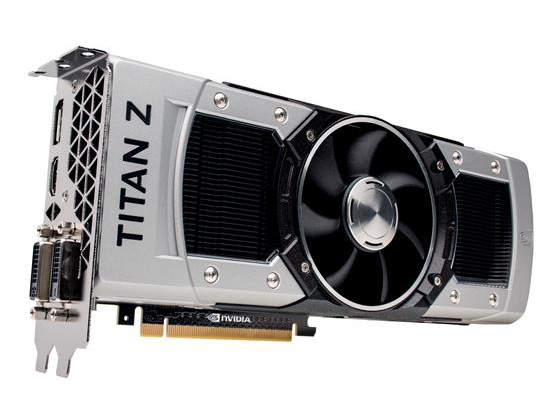GeForce GTX Titan Z: Dual GK110 Makes 5,760 Core Monster
This card features two GPUs and 12 GB of video memory.
This week during GTC 2014, Nvidia CEO Jen-Hsun Huang revealed a monster of a graphics card, the GeForce GTX Titan Z. This card features 5,760 CUDA cores, 12 GB of on-board frame buffer memory, and 8 TeraFLOPS of performance.
"If you're in desperate need for a supercomputer and you need one really close by and handy, and you want it to fit under your desk, we have just the friend for you," Huang said in his keynote.
The new Titan Z features two GK110 chips that are tuned to run at the same clock speed, and backed by dynamic power balancing so that the GPUs don't create a performance bottleneck. They're also engineered for multi-monitor gaming and 5K media.
"That performance is delivered in a card that is cool and quiet, rather than hot and loud," states Nvidia's blog on Monday. "Low-profile components and ducted baseplate channels minimize turbulence and improves acoustic quality."
Huang compared the new Titan Z to Google Brain, which features 1,000 servers packing 2,000 CPUs (16,000 cores), 600 kWatts and a hefty price tag of $5,000,000 USD. A solution using Titan Z would only need three GPU-accelerated servers with 12 Nvidia GPUs total.
In a demo, the company revealed simulation and graphics running simultaneously. Plankton illuminated the water, exposing a number of glowing jellyfish and an oncoming whale. Once the creature was completely visible in the scene, the whale jumped up out of the water and came crashing back down, causing believable ripples on the surface. What was really cool was to pan around the whale in mid splash in real time.
When the whale came reaching out of the water, it generated the waves simulation, their 2D grids, their 3D grids, their particle systems, their mist generators and foam generators, all of which was rendered in real time. As the whale landed, the weight pushed around a small raft. Very, very impressive stuff.
Get Tom's Hardware's best news and in-depth reviews, straight to your inbox.
The GeForce GTX Titan Z currently has a meaty price tag of $2,999 USD. Additional information will be provided to the press at a later date.

Kevin Parrish has over a decade of experience as a writer, editor, and product tester. His work focused on computer hardware, networking equipment, smartphones, tablets, gaming consoles, and other internet-connected devices. His work has appeared in Tom's Hardware, Tom's Guide, Maximum PC, Digital Trends, Android Authority, How-To Geek, Lifewire, and others.
-
billgatez I am getting sick of all the tards who think this is a gaming card and make fun of it price.Reply -
WargameHobbies Bwahahahaha $3000! I have much better things to spend $3000 on. In 6 months it'll be $599.Reply -
aaronmc I'm confused by this. It appears to be a dual-GPU Titan, which isn't unexpected in itself, but it costs 50% more than two Titan cards. In all likelihood, two Titans will have a larger performance envelope than this card will, meaning that the only reason to buy this card will be to save space in a multi-card arrangement. Is it really worth $1000-$2000 to save some space? This argument seems even more pertinent when one considers that the target market for this card is probably CGI artists who want greater rendering capacity in their already-large desktops, and not gamers who want MOAR POWRZ!1! I'm not one to cast aspersions, but this seems like greed on Nvidia's part.Reply -
Stevemeister Exploit bit-coin mining before the whole think collapses like a Ponzi scheme . . . :)Reply -
MaxxBot "I *might* have spent 1400-1600 for this card, not 3k..."I agree, it seems silly to price out the enthusiasts while most serious professionals are going to use the Tesla for ECC and other reasons. As someone who wants DP computing with decent price/performance I think I'll need to look to AMD eventually to get what I want.Reply

